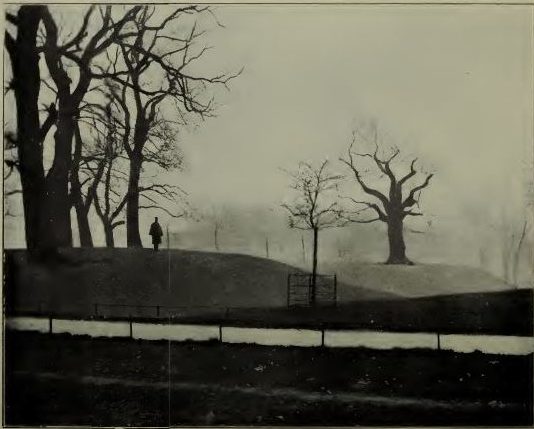There are two passenger pigeons at Horniman Museum in London. This one is in Birmingham. Even better, the Birmingham Museums have made the image freely available in their Digital Image Resource.

You begin to interest me…vaguely
There are two passenger pigeons at Horniman Museum in London. This one is in Birmingham. Even better, the Birmingham Museums have made the image freely available in their Digital Image Resource.

Here’s the Time Team episode from 2000, when the team excavated the Roman site in Greenwich Park. Surprisingly, they don’t get into the whole camel controversy, in fact, I don’t think they mention bones at all.
OK, so maybe there were no camels in Roman Greenwich, but that doesn’t mean there were never any camels around. Here’s a caravan of them in Blackheath, just south of Greenwich Park, in the 1950s:


T. Cregg Madrigal
©2018
Reviews of the archaeological record of camels in Europe include one reported occurrence from a Roman site in Greenwich Park, England. Examination of the site reports and the surviving bones from the Greenwich Park site indicates that it is unlikely that camel remains were ever found there, and therefore there is no existing osteological evidence for camels in Roman-Britain.
Download a pdf version of this article from the Research page.
Neither the one-hump dromedary (Camelus dromedarius) nor the two-hump Bactrian camel (Camelus bactrianus) is native to Europe, but both species of camel were used by the Romans. Scattered remains of both species of camel, as well as hybrids of the two, have been reported in Roman-era archaeological sites in Europe, including a single site in Great Britain, at Greenwich Park near London (Applebaum 1987:514; Bond 2017; Green 2017; Pigière and Henrotay 2012; Webster 1902).
While most of the other camel finds in continental Europe are based on relatively recent analyses of actual osteological material, the Greenwich Park record is based on a report dating back to the very early twentieth century (Webster 1902). A review of the published reports and an examination of the surviving bones from this site cast doubt on the presence of camel at Greenwich Park.
Former MLB relief pitcher Brad Lidge is most famous for his perfect season in 2008, when he went 48 for 48 in saves, including closing out the Philadelphia Phillies’ victory in Game 5 of the World Series. Since retiring from baseball in 2013, Lidge has earned a Master’s Degree in Roman Archaeology from the University of Leicester (thesis: Nails: An Underutilized Tool in Ancient Roman Archaeology), and has worked on excavations in Italy and England. Will he continue on for the Ph.D.? See the story in USA Today.


Hobley’s Heroes is an online archive that shows something of life as an archaeologist digging in London in the 1970s and 1980s, including dig site photos and an fanzine-like comic/workplace newsletter. Brian Hobley, Chief Urban Archaeologist, was their boss. It’s a fascinating repository that includes some far out field fashion and a glossary of the digger’s argot (“If in doubt, rip it out” was in use at least as early as 1974).

Before England fell in love with tea, there was coffee. Beginning in the 1600s, coffeehouses spread through England. Historians think of them as the more polite, refined counterpoint to taverns and alehouses, a place where the customers – mostly male – could drink and discuss and debate the news of the day.
It’s a bit surprising that almost no coffeehouses have been explored archaeologically, but Craig Cessford and colleagues now describe artifacts, tightly dated to between 1770 and 1780, from a small brick cellar associated with Clapham’s Coffeehouse in Cambridge, England.
So what’s the new thing I learned from the recent DNA-and-other-scientific-techniques analysis of the infamous Piltdown hoax fossils? Some people use the word “caveat” as a verb.
There it is, in the middle of the nicely open access article:
However, we caveat this by emphasizing that Bornean orang-utans have suffered from habitat loss and range fragmentation, two processes that can result in rapid shifts in the geographical distribution of genetic lineages (p. 7)
The internet helpfully tells me that the use of caveat as a verb in modern usage is considered awkward, and is most closely associated with Alexander Haig of “I am in control here” fame. Haig was a decade or two ahead of his time in his tendency to turn nouns into verbs.
There are a few caveats (“noun: a warning or proviso of specific stipulations, conditions, or limitations” -the OED) that may be worth keeping in mind regarding de Groote and colleagues’ article.
In combination, the geometric morphometric analyses link the Piltdown I mandible and Piltdown II molar; traditional morphometrics link the mandible with the canine, and ancient DNA analysis links the canine and Piltdown II molar. Therefore, given the nature of the context, we consider it highly likely that the Piltdown hoaxer(s) used a single orang-utan specimen originating from southwest Sarawak to construct parts of both Piltdown I and II (p. 7)
Reference:
DeGroote, I., et al.
2016 New genetic and morphological evidence suggests a single hoaxer created ‘Piltdownman’. R.Soc. Opensci.3:160328. http://dx.doi.org/10.1098/rsos.160328